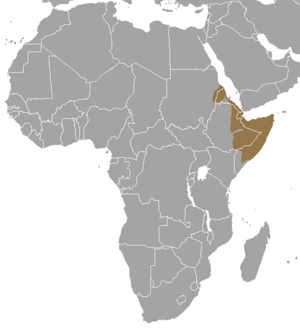Salt's dik-dik facts for kids
Quick facts for kids Salt's dik-dik |
|
|---|---|
 |
|
| Salt's dik-dik in the wild of Africa | |
| Conservation status | |
| Scientific classification | |
| Genus: |
Madoqua
|
| Species: |
saltiana
|
 |
|
| The range of Salt's dik-dik | |
Salt's dik-dik (Madoqua saltiana) is a tiny antelope. It lives in dry areas, bushy lands, and thick forests. You can find it in the Horn of Africa. It also lives a little bit in northern Kenya and eastern Sudan. This animal is named after Henry Salt. He was the first European to see this species in Abyssinia a long time ago.
About Salt's Dik-Dik
Salt's dik-diks are small. They are about 52–67 cm (20–26 in) long. They stand 33–41 cm (13–16 in) tall. They weigh between 2.5–4.0 kg (5.5–8.8 lb). Only the male dik-diks have small, pointed horns. Their fur color can be very different. It depends on where they live.
Types of Salt's Dik-Dik
Salt's dik-dik is part of a group called Madoqua. Another close relative is the silver dik-dik. Scientists study how these animals are related. They group them into different types. Sometimes, scientists have different ideas about how to group them.
Most scientists today agree that Salt's dik-dik has five main types, called subspecies:
- M. s. saltiana: These live in northern Ethiopia, Eritrea, and eastern Sudan. They are quite large. Their back is reddish-grey.
- M. s. hararensis: You can find these in the Hararghe region of eastern Ethiopia. They have a ginger-colored back. Their sides are dark red.
- M. s. lawrenci: These live in eastern and southeastern Somalia. They have a shiny, silvery back. Their sides are a russet (reddish-brown) color.
- M. s. phillipsi: These are found in Somaliland. Their back is grey. Their sides are orange.
- M. s. swaynei: These live in the Jubba Valley region. This area is in southern Ethiopia, southern Somalia, and northern Kenya. Their back is brown-grey.
Some scientists have suggested that each of these types might be its own unique species. But for now, most still call them subspecies.
Behavior
Salt's dik-diks are shy animals. They are most active at night and during dusk (evening) or dawn (morning). This helps them avoid the hot midday sun. They are often seen in pairs or small groups. Salt's dik-diks mainly eat leaves and shoots from acacia trees. They have a special body system. It helps them live in warm places.
Reproduction
Female dik-diks are pregnant for about 150 to 180 days. They usually give birth to one baby, called a cub, twice a year. The newborn cub stays hidden for at least two to three weeks. After just one week, a baby dik-dik can start eating solid food. But it will still drink its mother's milk for three to four months.
Young male dik-diks start growing their horns after about one month. Salt's dik-dik reaches its full adult size by eight months old. It stops growing completely around 12 months. Once a young dik-dik is old enough to have babies (around six to nine months), it finds a partner. Then, they create their own territory.


